![[image-01: Various cotton fabric swatches labeled with their names, showing texture and weave differences] - labeled-all xx](/media/articles/2190/71bdd146.jpg)
Cotton is one of the most versatile fibers in garment sewing. It's breathable, easy to care for, and comes in countless varieties that can be used for everything from delicate blouses to sturdy workwear. But just because a fabric is labeled "cotton" doesn't mean it will work for every project.
I've been sewing with cotton fabrics for decades, and I've learned (sometimes the hard way!) which types work best for different garments. In this guide, I'll break down the most common cotton fabrics you'll encounter, what makes them special, and which projects they're best suited for.
Remember that cotton is simply the fiber these fabrics are created with, but they can be woven or knit into many different weights and textures. Let's explore the most common types you'll find at the fabric store.
Voile and Lawn: The Delicate Lightweights
![[image: any image that has lawn or voile or both]](/media/articles/2190/f5b68567.jpg)
Voile and lawn are some of my absolute favorites to sew with. These are soft, smooth, and fine cotton wovens that have a beautiful drape while still maintaining some structure.
![[image-02: Close-up of cotton lawn fabric showing its fine, smooth texture, with a folded edge to demonstrate drape and a completed Sage blouse made in Liberty tana lawn]](/media/articles/2190/40eec76f.jpg)
Lawn has a slightly crisper hand than voile, while voile tends to be a bit more sheer. Batiste is another similar fabric you might encounter, which falls somewhere between the two in terms of weight and opacity.
These fabrics are incredibly versatile and work beautifully for light blouses, dresses, and even pajamas. Sometimes voile can be quite sheer and may need to be lined, so keep that in mind when planning your project.
I recently made the Sage blouse in Liberty tana lawn, and it's one of my favorite makes of the year. Liberty fabrics are more expensive, but the quality is remarkable—they feel like silk but with the practicality of cotton.
What I love most about these fabrics is how they offer a perfect balance of drape and body. They're substantial enough to hold shape in details like collars and cuffs, but fluid enough to create beautiful gathers and drape.
They're also a dream to press—the creases stay crisp where you want them, but they don't wrinkle excessively when worn.
Recommended Patterns:
-
The Fern top is perfect for these fabrics. The gathered neckline and raglan sleeves show off the beautiful drape of lawn and voile.
-
The Sage top features princess seams that really benefit from the structure and pressability of these fabrics.
![[Luiza Image insert 2a]](/media/articles/2190/299befaf.jpg)
Quilting Cotton: Proceed with Caution
If you've ever walked into a fabric store, you've probably been drawn to the quilting cotton section—with its rainbow of colors and endless prints. The variety is incredibly tempting!
But here's the truth: quilting cotton isn't really designed for garment sewing. That doesn't mean you can't use it—just that you need to choose your projects wisely.
![[image: labeled-quilting-cotton3]](/media/articles/2190/20665a39.jpg)
Quilting cottons are typically made from shorter cotton fibers, which makes them more durable but less fluid. They have a stiffer hand and don't drape as nicely as fabrics specifically designed for apparel.
I learned this lesson years ago when I made a Sloan dress in a beautiful quilting cotton. I had fallen in love with the print, but when I finished, the dress looked more like a pillowcase than a garment! The fabric simply didn't have the drape needed for the design.
If you do want to use quilting cotton for garments (and those prints can be hard to resist!), look for patterns with more structure that don't rely on drape. Crisp A-line skirts, structured tops, and pajamas are all great choices.
Recommended Patterns:
- The Leif pajamas are perfect for quilting cotton. Pajamas should be comfortable and easy to wear, but they don't require much drape.
-
The Basil quilted jacket works wonderfully with quilting cotton as the outer fabric, since quilting adds structure.
![[image: 4]](/media/articles/2190/ab40a54a.jpg)
Poplin: Crisp and Versatile
![[image: labeled-poplin]](/media/articles/2190/c2201f3a.jpg)
Poplin is a plain weave fabric with a tight weave that gives it an unmistakable crispness. In poplin, the weft yarns (running horizontally) are thicker than the warp yarns (vertical), creating a subtle ribbed texture.
When I'm working with poplin, I like to think of it as sewing with paper—it's thin and light, but very crisp. This mental image helps me visualize whether a pattern will work with this fabric. Poplin holds pleats and structured details beautifully.
![[image-03: Close-up of poplin fabric showing its characteristic ribbed texture and crisp appearance] -poplin.jpg (pleated)](/media/articles/2190/e444fdd6.jpg)
It's lightweight but durable, and it resists wrinkles better than many other cotton fabrics, making it a practical choice for everyday wear. I find it's particularly good for button-up shirts, structured dresses, and full skirts that need to hold their shape.
Recommended Patterns:
- The Romie top with its Peter Pan collar benefits from poplin's crispness, giving it a polished, tailored look.
- The Chantelle shirt dress is another great option. Poplin provides the perfect structure for the princess seams and collar while being comfortable for all-day wear.
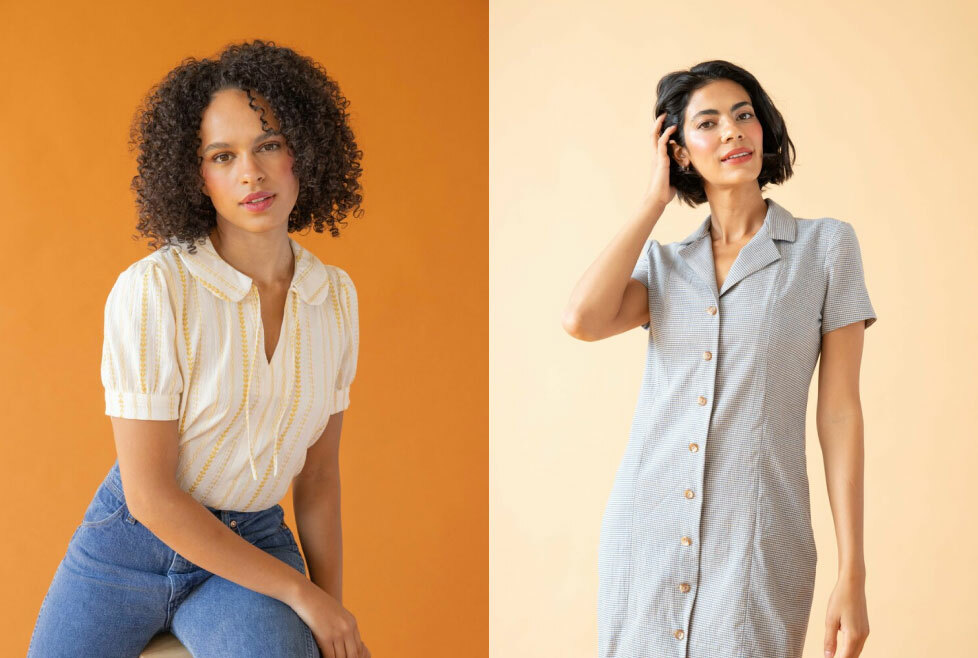
Shirting: A Button-Up's Best Friend
![[image7: labeled-shirting]](/media/articles/2190/2fd8082c.jpg)
When you see fabric labeled as "shirting," you're looking at a category that can vary widely in quality. The best shirting fabrics are soft, drape well, and are made from long-staple cotton fibers.
High-quality shirting has a beautiful hand and a subtle sheen. It's designed specifically for button-up shirts, with enough structure to hold collars and cuffs crisp while still being comfortable to wear.
![[image-04: Close-up of high-quality shirting fabric, showing the fine thread count and smooth surface alongside a sample of a flat-fell seam]](/media/articles/2190/dfe33b4c.jpg)
A flat-fell seam, which is the traditional finish on classic shirts, works beautifully with shirting fabric. If you're investing in good shirting, take the time to master this technique—it creates a clean, professional finish that's worth the extra effort.
Another type of shirting you might encounter is oxford cloth, which has a basket weave structure that creates a slightly textured appearance. Oxford is a bit more casual and rugged than fine shirting, making it perfect for everyday wear.
Recommended Patterns:
- The Sam top is designed specifically for shirting fabrics. Its collarless design and pleated sleeves showcase the fabric's drape while maintaining structure.
- The Roan tunic is an oversized button-down that works beautifully in shirting. The loose fit allows the fabric to move and breathe.
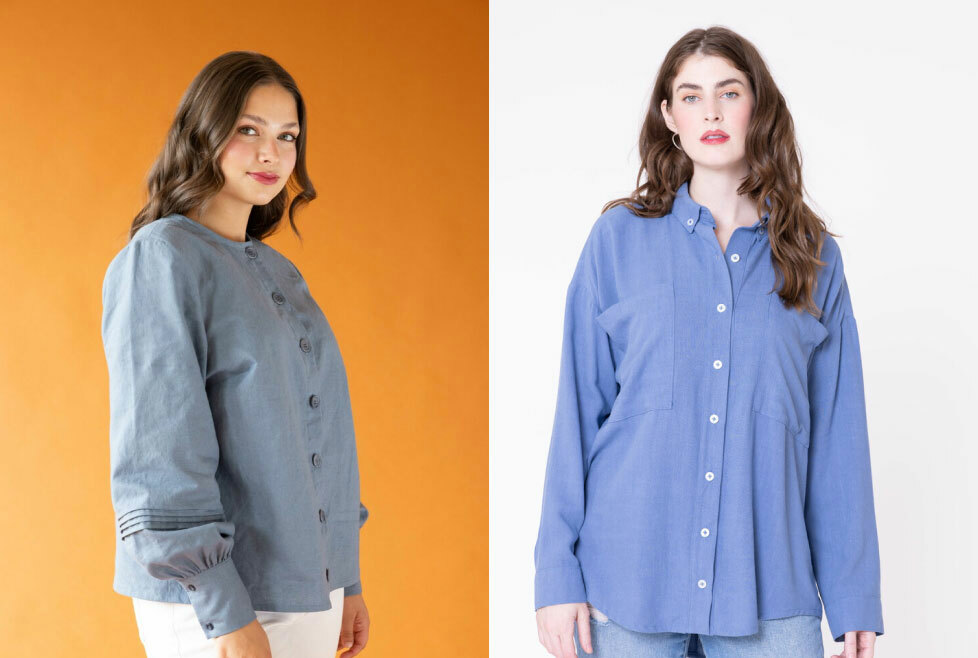
Eyelet: Feminine and Fun
I absolutely love eyelet cotton! This fabric features small embroidered holes (the eyelets) that create beautiful texture and visual interest.
![[image: labeled-eyelet]](/media/articles/2190/4b2381dd.jpg)
Eyelet often comes with a scalloped or embroidered border that can be strategically placed along hems, cuffs, or necklines for a decorative touch. Planning your cutting layout to take advantage of these borders can elevate a simple design to something special.
Since eyelet is light and often somewhat sheer, it's best for projects where that sheerness is either an advantage or can be easily lined. I recently made the Baker dress with a combination of plain linen and eyelet cotton, placing the eyelet along the front yoke where a little peek of skin adds interest without requiring a full lining.
![[image-05: Close-up of eyelet fabric showing the embroidered pattern and holes alongside a completed eyelet garment with scalloped edges at the hem]](/media/articles/2190/72c24195.jpg)
I particularly love eyelet for gathered or tiered skirts because it's easy to place those beautiful scalloped edges along the hem. The weight of eyelet also gives lovely volume to gathered designs.
If you want to learn all my tricks for working with eyelet, I created a complete video tutorial that covers everything from pattern layout to seam finishes.
Recommended Patterns:
- The Leighanne empire waist dress is perfect for eyelet, especially with the member bonus ruffle version where you can showcase scalloped edges.
- The Baker dress works beautifully with eyelet as well, especially when you use it for the yoke as I did in my version.
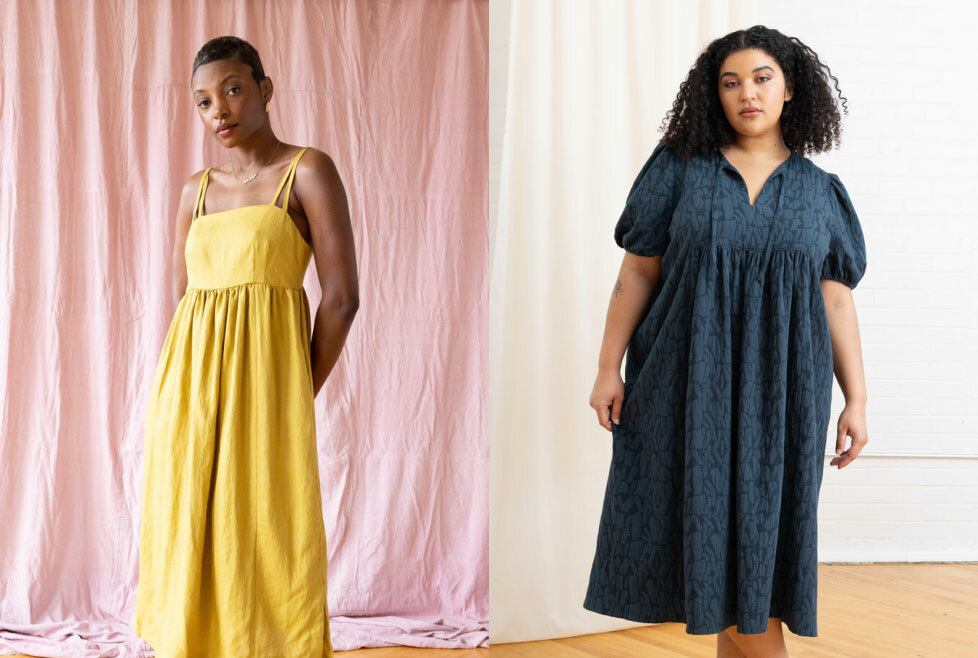
Cotton Twill and Denim: The Hardworking Heavyweights
Denim is one of my all-time favorite fabrics to sew. It's incredibly versatile, goes with everything, and has a timeless appeal that never goes out of style.
![[image: labeled-denim]](/media/articles/2190/a99657f6.jpg)
Denim is made of cotton (sometimes blended with spandex for stretch) in a heavy twill weave. You'll notice what looks like diagonal ribs on the fabric—that's the twill weave, which makes the fabric very durable while giving it a slight amount of natural give.
When sewing with denim, be sure to use a needle specifically designed for it. These heavier-duty needles can penetrate the thick fabric without breaking. You might also want to invest in topstitching thread if you're going for that classic jeans look with visible stitching.
![[image-06: Close-up of denim fabric showing the characteristic diagonal twill weave and demonstration of using a clapper to press a denim seam flat]](/media/articles/2190/ae859274.jpg)
One of my favorite tools when working with denim is a clapper—a smooth block of wood that helps press seams flat. Denim can be quite bulky, and seam intersections can quickly become unwieldy if not properly pressed. The weight of the clapper helps create crisp, flat seams even in thick fabric.
While jeans are the obvious choice for denim projects, don't limit yourself! Denim also works beautifully for structured dresses, skirts, jackets, and even some tops. I've made several Chelsea jeans in different colors of denim, and they've become wardrobe staples.
Recommended Patterns:
- The Ulla shift dress in a lightweight denim creates a professional but comfortable dress that transitions well from office to casual wear.
- The Leonora skirt is designed specifically for denim and features classic jean details like topstitching and patch pockets.
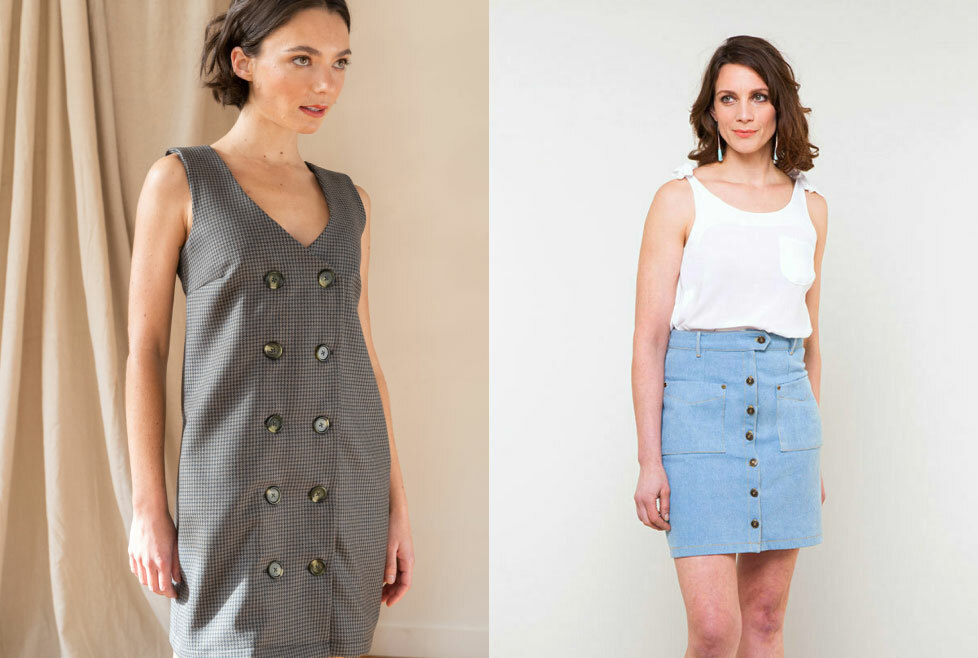
Canvas, Seersucker, and More Specialty Cottons
Beyond the most common cotton fabrics, there are several specialty types worth exploring for your projects.
![[image: labeled-canvas, labled-seersucker]](/media/articles/2190/e2043773.jpg)
Canvas is a heavy, plain-weave fabric similar to what tote bags are made from. It's incredibly durable and holds its shape well, making it perfect for structured garments like the Effie shorts or the Parker chore coat. When sewing with canvas, use heavy-duty needles and be prepared to manage bulk at seam intersections.
Seersucker has a distinctive puckered texture that's created during the weaving process. I made my Benning dress in a lightweight blue seersucker last summer, and it's become one of my most-worn garments. The fabric naturally resists wrinkles, making it perfect for travel or for those of us who don't love ironing! Try it with the Eden shirt or Sloan dress.
Stretch cotton wovens combine the structure of woven cotton with a touch of spandex for comfort and ease of movement. When sewing these fabrics, I recommend using a narrow zigzag stitch (around 0.75mm width) rather than a straight stitch to allow for stretch. These fabrics are ideal for fitted garments like the Nolan pants or the Brookes skirt.
Cotton Knits: T-Shirt Basics and Beyond
While we've mostly discussed woven cotton fabrics, cotton knits deserve their own section. These are the fabrics your favorite t-shirts are made from, and they range from lightweight jerseys to substantial sweatshirt fleeces.
![[image: labeled-jersey or labeled-knits]](/media/articles/2190/b2cc5147.jpg)
Cotton jersey is the classic t-shirt fabric—light to medium weight with moderate stretch. One thing to watch for with pure cotton knits is recovery—they don't always spring back to shape as well as blends do. To test recovery, stretch a fabric swatch and see if it returns to its original size. If it stays stretched out, you might want to look for a cotton-spandex blend instead.
![[image-08: Assortment of different cotton knit fabrics showing varying weights and structures, including jersey, rib knit, and French terry]](/media/articles/2190/8e7ee356.jpg)
Rib knits, with their distinctive raised texture created by alternating knit and purl stitches, offer the best recovery of the cotton knits. They're perfect for neckbands, cuffs, and garments where you want more structure.
Heavier options like sweatshirt fleece and French terry are perfect for cozy sweaters and casual wear. French terry has a smooth face and loops on the back, while sweatshirt fleece has a brushed interior for added warmth.
Recommended Patterns:
- The Callen sweater works beautifully in a stable cotton knit like French terry or interlock.
- The Aaronica dress or top is perfect for cotton jersey, creating a fitted but comfortable garment for everyday wear.
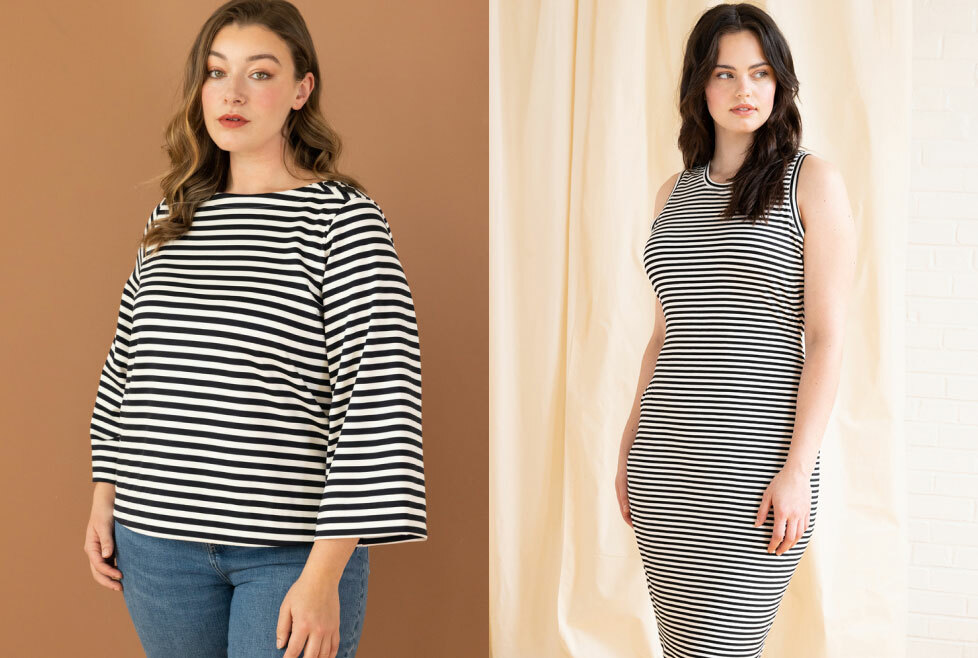
Bonus Tip: Consider Organic Cotton
Before wrapping up, I want to touch on organic cotton as an important consideration for environmentally conscious sewists.
Conventional cotton production uses significant amounts of pesticides and water. In fact, traditional cotton farming accounts for about 16% of global insecticide use, despite using only 2.5% of the world's cultivated land.
Organic cotton is grown without synthetic pesticides or fertilizers, using methods that have less environmental impact. It also tends to use less water and produces fewer greenhouse gas emissions. When you choose organic cotton, you're supporting more sustainable farming practices.
From a sewing perspective, many sewists find that high-quality organic cotton fabrics have a particularly nice hand and last longer. While they may cost a bit more, the combination of environmental benefits and fabric quality often makes them worth the investment.
Many fabric stores now carry organic options across different cotton types, from lightweight lawns to heavy denims. If sustainability is important to you, look for GOTS certification (Global Organic Textile Standard) which ensures the fabric meets strict environmental and social criteria.
Final Thoughts
Cotton truly offers something for every sewer and every project. Understanding the differences between these cotton varieties helps you make better fabric choices and avoid disappointment.
![[image-10: A collection of completed garments made from different cotton fabrics, showing the versatility of cotton across various styles] -Variety image](/media/articles/2190/d22b2a6e.jpg)
Remember, the right fabric can make or break your project. Take the time to consider what properties your garment needs—drape, structure, stretch, or texture—and choose a cotton that will highlight those elements.
